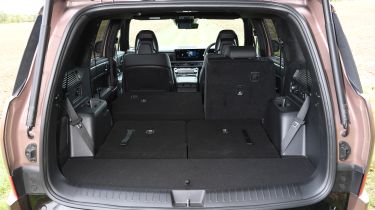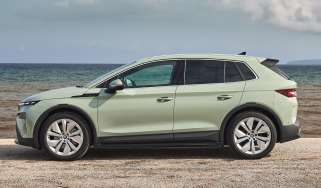Hyundai Santa Fe - Boot space, comfort and practicality
Offering lots of space and seven seats as standard, the Hyundai Santa Fe is for larger families

There’s a huge amount of space inside the latest Santa Fe, and every version is fitted with seven seats as standard. However, the top-of-the-range Calligraphy trim is available with a six-seat configuration that includes two individual captain’s chairs for the middle row.
Alternatively, if you’ve got young children and need a family car that can handle multiple child car seats, the Santa Fe features four sets of ISOFIX mounting points – two on the middle bench, and another two on the rearmost seats. Folding down the second row seats is done with the push of a button, and the third-row seats have straps that make folding them down even quicker and easier.
| Dimensions | |
| Length | 4,830mm |
| Width | 1,900mm |
| Height | 1,780mm |
| Number of seats | 7 (6 as an option) |
| Boot space | 628-1,959 litres (5 or 2 seat modes) |
Dimensions and size
Measuring 4,830mm from nose to tail, the Hyundai Santa Fe Mk5 is 45mm longer than the old model. It’s longer, wider and taller than its key rivals, particularly the Skoda Kodiaq and Peugeot 5008, but a width of 1,800mm means it’s not as unwieldy as some wider premium SUVs, such as the Volvo XC90 or Land Rover Defender.
How practical is the Hyundai Santa Fe?
Seats & space in the front
While the centre console is broad, there’s still plenty of room, and a wide range of seat and wheel adjustment will suit all body shapes behind the wheel.
More reviews
Car group tests
- Skoda Kodiaq vs Hyundai Santa Fe: a 7-seater SUV showdown
- Audi Q5 vs Volvo XC60 vs Hyundai Santa Fe: 2021 group test review
- Mitsubishi Shogun Sport vs Hyundai Santa Fe vs Skoda Kodiaq
In-depth reviews
Long-term tests
Road tests
Used car tests
The Santa Fe is bursting with storage options, including deep door bins, a very deep armrest bin with two levels and a lid that is hinged at both ends so it can be opened from the front or rear. There are a pair of gloveboxes ahead of the front-seat passenger, too, and in top-spec Calligraphy trim the upper compartment features a UV-C sterilisation tray, which Hyundai says is a first for a production car.
Pop something inside – it’s a narrow space, so only thin items such as gloves, keys or smartphones will fit – shut the door and press the UV-C button on the dash. Items are then blasted with ultraviolet rays for 10 minutes to clean them of bacteria, viruses and other such nasties.
Seats & space in the back
A tall roof means headroom isn’t an issue in the Santa Fe, while shoulder space in the middle row is fine when travelling three-up. There’s a flat floor, and the front seat backs are hard plastic, so will take a kicking from careless feet. There are bag hooks on them, too, as well as USB sockets on the sides of the front seats. There are air vents on the B-pillars to help with ventilation, and they should be handy for those in the back on a hot summer day.
The middle row slides back and forth, and this helps with access to the rearmost row. Once there, space is reasonable, but still tight for adults, while the upright tailgate means your head isn’t close to the rear screen.
Recessed handles in the C-pillars are designed to help when climbing up to the roof bars or into the back. Straps on the rearmost seat backs mean they can be lifted easily, while the back row has air vents and USB ports.
Boot space
The large tailgate is electrically operated, and it opens high to allow you to stand beneath it, plus there’s a low loading lip. Hyundai doesn’t quote boot space in seven-seat mode, but there’s room to play with – although not as much as you’ll find in a Skoda Kodiaq.
The hybrid model has a 628-litre boot in five-seat mode, and this increases to 1,949 litres with all the rear seats folded. The plug-in hybrid (PHEV) is slightly smaller, with figures of 621 and 1,942 litres. One minor issue is that there’s nowhere to put the load cover when it’s not in use. All models feature self-levelling suspension.
Towing
One area where the Santa Fe really falls behind its rivals is with towing. There’s a maximum capacity of 1,110kg irrespective of whether you choose the PHEV or the hybrid, or even if you opt for four-wheel drive for the latter. That’s a shame, because a car such as this would be the perfect tow car option otherwise. In comparison, the PHEV version of the Skoda Kodiaq can haul 1,800kg (as can the standard petrol versions), and the diesel can tow up to 2,400kg in its most powerful guise.
Which Is Best
Cheapest
- Name1.6 TGDi PHEV Calligraphy 5dr 4WD Auto [6 Seats]
- Gearbox typeSemi-auto
- RRP£59,225
Most Economical
- Name1.6 TGDi PHEV Calligraphy 5dr 4WD Auto [6 Seats]
- Gearbox typeSemi-auto
- RRP£59,225
Fastest
- Name1.6 TGDi PHEV Calligraphy 5dr 4WD Auto [6 Seats]
- Gearbox typeSemi-auto
- RRP£59,225








